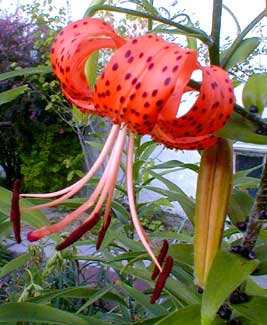
About Our 'Splendens' Tiger Lily
Together with a discussion of
turk's-cap lilies as ancient symbols
of the Mother Goddess
"The panthers of the meadow,
tiger-lilies."
-Titus Munson Coan
1801-1882
1801-1882
'Splendens' Tiger Lily (Lilium lancifolium var splendens, still often listed under its former name L. tigrinum var splendens) has larger flowers, shorter stature, & fewer speckles than most Tiger Lilies.
In 1870 it had its variant name bestowed upon it by a German botanist, Max Leichtlin (1831-1910). That year it had been discovered by chance with other oriental lilies shipped from Japan to M. Linden of Brussels, Belgium. Half a bulb was provided by Linden to Leichtlin who cultivated it successfully, then provided bulbs to the firm of Van Houtte in Ghent, & thereafter the world-wide distribution of so impressive a flower as 'Splendens' was inevitable.
Native to China, Korea, & Japan, in Japan tiger lilies are called Oni-yuri, Devil-lily, because oni devils are typically red, & so are tiger lilies, though a yellow variant has extended the color range (see Lancifolium var flaviflorum 'Yellow Star'). In China, they are grown as an edible vegetable. The bulb when cooked is reminiscent of turnips. Flower buds are eaten raw or cooked although the pollen may be toxic, & is said to induce vomiting, so opened flowers must be well cooked to break down any toxin; cooked blooms make good soup thickeners.
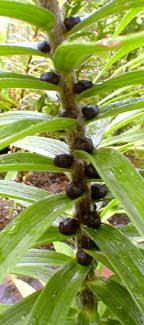 Lilies with such dangly reflexed blooms are called "Turk's-caps," do to a resemblance to a gaudy. Ottoman Empire sultan's turban. A mature specimen can produce a dozen or even two dozen of these showy flowers on a single stem.
Lilies with such dangly reflexed blooms are called "Turk's-caps," do to a resemblance to a gaudy. Ottoman Empire sultan's turban. A mature specimen can produce a dozen or even two dozen of these showy flowers on a single stem.As an ancient hybrid, it is sterile & does not produce seed; but it produce little black bulbils along the axils of the leaves (shown in the second photo, snapped in July). These are easily propagated in pots to get them started; harvest the seeds just as they start to fall from the stems late in summer. These take three years to mature sufficiently to flower.
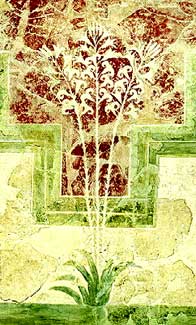 As a species, Tiger Lily has never been found in the wild, & does not spread from gardens. Some botanists speculate it is of hybrid origin, a cross of L. leichtlinii & L. maculatum. But having been cultivated for thousands of years, its precise origin is lost to the mists of time. The evidence of Minoan pottery & frescoes indicates that just such a turks'-cap lily was known in ancient Crete, & had a sacred significance.
As a species, Tiger Lily has never been found in the wild, & does not spread from gardens. Some botanists speculate it is of hybrid origin, a cross of L. leichtlinii & L. maculatum. But having been cultivated for thousands of years, its precise origin is lost to the mists of time. The evidence of Minoan pottery & frescoes indicates that just such a turks'-cap lily was known in ancient Crete, & had a sacred significance.Here at the left is shown a Minoan fresco from the Cretan Villa of the Lilies, dating to 1,500 B.C.E., when the Villa was destroyed in a tsunami or an earthquake. This fresco is badly faded, but the tall lily is quite obviously a silhouette of the turk's-cap variety. This same image dominates the famous Lily Vase found in the palace of Knossos & today in the Heraklion Museum of Crete. As these are white turk's-caps, they are probably Lilium martagon (still associated with the Feminine Divine in that it is today called Madonna Lily), but red examples are also to be found in Minoan representations.
For example, a similar fresco from the island of Thera dates to the same period. It shows bright red lilies with black swallows darting in & out among the flowers. A detail of the Thera fresco of tiger lilies & swallows is shown here at the right, courtesy of Steve Bogdanoff of the Bogdanoff Gallery in New Orleans. The cultic significance of this comparison to swallows will be made evident below.
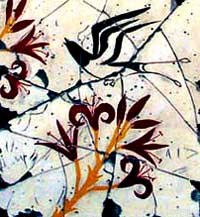 The decorated shrine-room was associated with harvest rituals. Even biblical evidence hints at why the Thera fresco associates Swallows & Tiger lilies, for the swallow's name in semitic languages (sus) puns with the semitic word for lily (shushan) which is in turn homonymous with the goddess En-susinak who had either the form of a lily or a bird (doves were sacred to Cybelle & Astarte, but it would appear that the swallow was En-susinak's bird).
The decorated shrine-room was associated with harvest rituals. Even biblical evidence hints at why the Thera fresco associates Swallows & Tiger lilies, for the swallow's name in semitic languages (sus) puns with the semitic word for lily (shushan) which is in turn homonymous with the goddess En-susinak who had either the form of a lily or a bird (doves were sacred to Cybelle & Astarte, but it would appear that the swallow was En-susinak's bird).Now the sacred Turk's-cap lily needn't have been spotted so could have been a fertile Red Turk's-cap of another species, L. chalcedonicum the primary suspect. And indeed, probably any reflexed lily would have had the same meaning. But there are reasons to suspect the sacredness of the lily from a very ancient time was inclusive of the spotted tiger lily, first for the very association with tigers but more probably the leopard/panther, the spots of which Pliny knew to be symbolic of the phases of the moon.
An additional clue is the very sterility of the tiger lily which was passed down to us from the ancient world exclusively due to the activity of human devotion to these flowers. The very first culture to preserve sterile flowers were the Minoans, without whom there would not be such a thing as a saffron crocus, which spread throughout the ancient world from Crete strictly as a cultivated flower that does not produce seeds. Saffron was most famed because not only was it sacred to the Mother Goddess, but its spice was worth more than gold (see the related essay on Saffron Crocus mytholgy). Yet other sacred flowers were certainly cultivated, & the mysterious origins of the tiger lily would seem to have at least an indirect & possibly a direct connection ancient Cretan cultivation of sterile flowers in honor of the Mother of the Dawn. If the unknown ancestor of the tiger lily originated in Asia, then a convergence would have occurred as the saffron crocus went eastward along trade routes to China, & the tiger lily (or wild lilies that gave rise to the cultivated tiger) went westward along the same trade routes.
In biblical Hebrew, such true lilies are called Shushan, which was simultaneously the Hebrew name of the Great Goddess En-susinak of Medes or Persia. Shushan was a common girls' name in the ancient world & remains so today (Susan). The heroine of the Book of Esther, named for Ishtar, dwelt in the city of Susa, sacred city of the divine coulple El-susinak & En-susinak. The Jewish heroine Susanna, named for the same Goddess, dwelt similarly in Susa.
Many commentators have suggested this flower should've been called Leopard Lily, not Tiger, because it is spotted, not striped. Most have decided it was named for the orange color of the tiger, rather than for the markings. I've wondered just how long it has been known as a "Tiger," however, & if it couldn't actually be named for the Tigris River, where panthers once dwelt. Tigris in Latin & Greek is really derived from Persian, where the name was more likely applied to panthers, as well as to the holy river; & this is the same as the panther or the lion upon which numerous goddesses were depicted standing, including Ashtoreth for whom King Solomon built a temple at exactly the same time he was building of the temple of Yahweh. And it may be no coincidence that Solomon's bride was "from the mountains of the leopards" [Song 4:8], alluding to the vehicle of the Mother Goddess; & when Solomon goes down to the garden "to gather lilies" [6:3] & when he eats lilies [2:16; 6:2], these allusions are simultaneously sacred & erotic, as well as regarding the getting of wisdom as represented by the opening lilies.
The Goddess Shushan or En-susinak with her consort El-susinak were worshipped throughout the Persian or Elamite empire, where dwelt the Israelites during a time of exile. The capitol, Susa, was east of the Tigris River. Not inconceivably, original wild forms of the Tiger Lily became extinct because they were exterminated by rival cults after the cult of Shushan was displaced, but it may once have grown wild or cultivated along the broad plane between Tigris River & Susa, the city no less famed than Babylon famed for its flowers. The lilies were sacred to Babylonian, Elamite, & Parthian worshippers of Shushan for a long while after the fall of Minoan high culture.
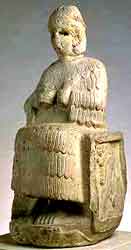 This Lily-goddess of the Tigris resembled an enthroned Cybele. Just such a goddess is shown on this page, an idol found at Susa. She was also a pillar-goddess similar to the Israelite goddess Asherah, who was worshipped even in Yahweh's temple until the time of King Josiah.
This Lily-goddess of the Tigris resembled an enthroned Cybele. Just such a goddess is shown on this page, an idol found at Susa. She was also a pillar-goddess similar to the Israelite goddess Asherah, who was worshipped even in Yahweh's temple until the time of King Josiah. A second depiction shows En-susinak as an upright pole made of masonry bricks. Cybele was the inventor of masonry & in Hittite, one of the pictographs spelling her name was a square brick or perhaps a birthstone as alluded to in the Babylonian creation myth as the brick over which Mami Aruru gave birth to sundry races of humanity. Nintu or Mami Aruru had the title sassuru meaning "birthing goddess," which puns with Shushan, which in turn puns with the Akkadian wird sasu, to call, as to call forth creation, & this feeds back to the Persian meaning of sus, "origination," because Shushan was the origin of the world. Nor can it be only coincidence that in the extensive Hindu pantheon, Sushan, Sushana & Bishkala occur as goddesses of the spreading pelvis & loosening womb, invoked for ease of parturition; similar birth-goddesses attended Mami Aruru in the Babylonian creation & flood myth.
A second depiction shows En-susinak as an upright pole made of masonry bricks. Cybele was the inventor of masonry & in Hittite, one of the pictographs spelling her name was a square brick or perhaps a birthstone as alluded to in the Babylonian creation myth as the brick over which Mami Aruru gave birth to sundry races of humanity. Nintu or Mami Aruru had the title sassuru meaning "birthing goddess," which puns with Shushan, which in turn puns with the Akkadian wird sasu, to call, as to call forth creation, & this feeds back to the Persian meaning of sus, "origination," because Shushan was the origin of the world. Nor can it be only coincidence that in the extensive Hindu pantheon, Sushan, Sushana & Bishkala occur as goddesses of the spreading pelvis & loosening womb, invoked for ease of parturition; similar birth-goddesses attended Mami Aruru in the Babylonian creation & flood myth.One recurring image of the Mother Goddess in the Near East was of a slim, long-haired woman holding a long-stemmed lily in each hand, held to each side, or in some cases a winged woman framed by flowering stems of two giant lilies, which conceivably bare some relationship to the guardian cherubim which Genesis associates with the Tree of Life & the Tree of Knowledge.
The same physical posture is taken by goddesses similarly depicted holding sheafs of grain, or in some cases holding lions by their throats, or in more northerly parallels, Artemis clutching reindeer by their throats, one to the left & one to the right; or in Minoan cult, holding snakes to left & right. The holding of the lilies may well have evoked for ancient worshippers the holding of panthers or serpents. One Semitic plaque shows a goddess with lily in one hand, serpent in the other. Shown here at the left is a Syrian image of Anath (Astarte) holding two lilies. This was the very Goddess worshipped as Yahweh's bride at Bethel, the first sacred city of the Israelites.
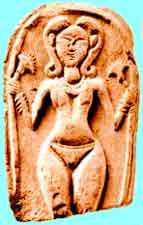 The exact cultic meaning of the lily-clutching is very little known from textual sources, but we may suppose the lily of droughty or desert regions had much the same meaning as did water lotuses in regions of greater rainfall: a symbol of birth, fruitiveness, dawn, & the awakening of divine knowledge.
The exact cultic meaning of the lily-clutching is very little known from textual sources, but we may suppose the lily of droughty or desert regions had much the same meaning as did water lotuses in regions of greater rainfall: a symbol of birth, fruitiveness, dawn, & the awakening of divine knowledge.Akin the Roman Flora, Shushan was represented by all flowers & presided over spring & all sexual relations. There are many associations between Solomon & this Goddess of Love (or Wisdom), so that the "lily-work" at the top of the pillars of the Temple may indeed have represented En-Susinak, especially given that a pagan architect of Tyre & numerous pagan builders designed & built the Temple [1 Ki 7:19, 22]. En-Susinak was patroness of Persian architecture, & even into relatively modern times, harem queens were the patronesses of architects. A midrash suggests that a portrait of Shushan was engraved upon one of the gates in the courtyard of the Temple [Mishnah Middoth 2:6], & to this day the Persian Jews in Jerusalem call their district Shushanat, which can be read as "Lily of Anath."
As a stone pillar or a patroness of masons & builders, allusions to this Goddess survive in scripture, as when the book of Esther speaks of pillars of Susa [Esther 1:6]. There are biblical intimations of the Earthmother sustained by pillars, with God in savage moments causing these pillars to tremble [Job 9:6; 26:11; 1 Sm 2:8]. The Song of Solomon is frankly coopted from an even more ancient poem to the Mother Goddess & her consort, & when Solomon sings "My darling, you are like My Mare" [Song 1:9], the word for Mare is Susah, & the Lily-goddess of Persia was in fact sometimes depicted as a mare, & her consort Il-susinak was a stallion (Sus).
A condemnation of the Horse-god & Horse-goddess among the Israelites may be detected in Jeremiah's description of the Lusty Stallion & his Wife [Jr 5:8]; in the proverb of a foolish horse that deserves to be whipped [Pr 26:3]; & the psalm that compares Horses to God & finds the former inferior, for the Horses will fall while God will remain upright [Ps 20:7-8], which can be an allusion to idols toppled. Because of the alien association of horse cults, Israel was warned not to rely on the horses, but on God [Hosiah 14:3].
Solomon was faulted for his excess of wives at the beginning of Chapter 11 of first Kings, immediately after the end of Chapter 10 where he was faulted for excessive devotion to horses [1 Ki 10:26, 28; compare 2 Chr 1:14, 16-17; 9:28; Song-Rabbah 1.1.10]. These verses are not interupted, & imply a similarity between the wives who all worshipped alien gods, & the horses who had the same representational meaning. Solomon was said to have fallen from glory because of his many foreign wives' temptations to worship beside them in their sundry cults, & he went so far as to construct not only the famous Temple of Ashtaroth, but also a stable that was as lavish as a palace [2 Chr 9:25], probably itself a kind of temple.
Just as he had built the Ashtoreth temple for his Sidonian wife, the altars of the Asherah grove for his Moabite & Ammonite wives, & the palace of his Egyptian wife wherein she honored her Egyptian gods, so too the stables were the province of the Elamite wife. In this palace or temple of horses, Solomon's Elamite/Persian wife oversaw the care of horses & chariots [Isa 22:6]. Stallion & mare were manifestations of El-susinak & En-susinak, for which reason it was said, "Elam was there, with all her multitude" [Ezek 32:24].
The supernal Stallion-god was known to the author of the book of Job as a divinity laughed at by an Ostrich-goddess [Job 39:13-19], probably because En-Shusinak was additionally emblemized as a type of bird. Shushan could well be the speaker of the verse, "Like a swallow (sus) or a crane I clamor, I moan like a dove" [Isa 38:14], & she was the Swallow among the birds (angels) of heaven who marked the hours & years to come [Jr 8:7]. Again to refer to the Hittite pictographic representation of the name of Cybele or Kubaba, a Dove pictogram which simultaneously stands for a Meteorite is included as part of Her name, the Goddess descending from heaven in the form of a bird or shooting star.
Solomon's Elamite wife as worshipper Shushan is the speaker in the verse "I am Shoshan of the valley" [Song 2:1], wherein this wife identifies herself as an avatar of En-susinak, & Solomon is El-susinak. Just as Solomon's Sidonian wife convinced him to pay homage to Ashtoreth, his Moabite wife similarly promoted Milcom, & the Ammonitess promoted Molech [1 Ki 11:5-7], so too the Elamitess induced him to pay homage to Shushan, for "So he did for all his foreign wives who burned incense & sacrificed to their deities" [11:8].
It was by the influence of the Elamitess that Solomon's Tyrian architect created an enormous brazen pool within the Temple in the shape of a Lily [7:26], filled with water, such as the Elamites said flowed from the Mother Goddess. This brazen bowl was upheld by twelve Apis bulls [23:25], symbolic of all gods sustaining the Goddess, much as in Hindu Sakta iconography, the gods Shiva, Brahmah, Visnu, & Rama are depicted upholding the vastly larger Mahadevi (Great Goddess).
"Now the capitals that were upon the pillars in the vestibule were of Lily-work" [7:19, & 22] means these pillars were the "work" (maaseh, literally "accomplishment") of the Elamite wife, who afterward boasted of herself as "a Lily among thorns" because she had done better than the other maidens [Song 2:2]; that is, her contribution to the Temple exceeded that of any of the thorny demonesses who were Solomon's many foreign wives. This is why Josephus said that the oxen under the Brazen Sea in the Temple, & the lion idols at the sides of his throne, were established in order to please his foreign wives [Ant VIII 7:5].
For all these reasons & others, Yahweh complained, "This city has aroused my anger & wrath from the day it (the Temple) was built, so I will remove it from my sight" [Jr 32:31], though this is a specifically Yahwist stance & ancient judaism was otherwise exceedingly amenable to the idea of Yahweh having a bride. The form of judaism that survived at Elephantine in Egypt centuries after the fall of the Temple had been exported from the oldest cult of Yahweh at Bethel, & in Elephantine Jews worshipped the Mother Goddess as Bride of Yahweh, called either Anathyahweh or Anathbethel. This openhearted love of the Goddess existed also in Jerusalem as a purely judaic cult, but Yahwists who were a minority who became a ruling elite shaped the derogatory take encountered in the Bible, but the important feature remains that the Goddess was there, even in the Jerusalem Temple, & in mystical Judaism, the Temple never ceased to be regarded as the personal home for the Divine Shekhinah, a female manifestation of God.